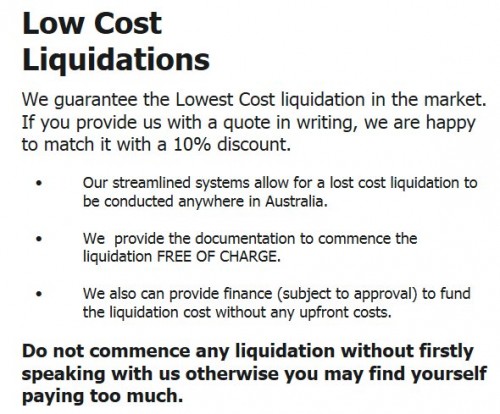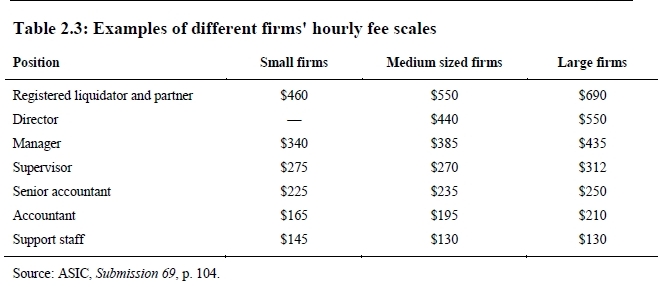When the Insolvency Law Reform Bill 2014 is passed, creditors in an external administration of a company (except under receivership or provisional liquidation) will be granted the power to have the external administrator’s fees reviewed by another external administrator. In the draft legislation, the person appointed by creditors is called a reviewer, a reviewing liquidator and, occasionally, a cost assessor.

The following table sets out the proposed legislation by using extracts from the Bill and related official material.
SUBJECT: CREDITORS’ REVIEW OF REMUNERATION OF EXTERNAL ADMINISTRATORS
SELECTED EXTRACTS FROM THE DRAFT BILL, PROPOSED RULES, ETC. |
SOURCE OF TEXT |
| 5-20 Meaning of external administrator of a company
A person is an external administrator of a company if the person is: |
Insolvency Law Reform Bill 2014 Exposure Draft, Insolvency Practice Schedule (Corporations), section 5-20, page 157 |
| 90-22 Application of this Subdivision
This Subdivision applies in relation to a company that is under external administration, other than a company in relation to which a provisional liquidator has been appointed. |
Insolvency Law Reform Bill 2014 Exposure Draft, Insolvency Practice Schedule (Corporations), Subdivision C section 90-22, page 263 |
| Appointment to carry out review (1) A registered liquidator may be appointed to carry out a review into either or both of the following matters: (a) remuneration of the external administrator of the company; (b) a cost or expense incurred by the external administrator of the company. Appointment by resolution (2) The appointment may be made by resolution of: (a) the creditors; or (b) if the company is being wound up under a members’ voluntary winding up—the company; (3) If the appointment is made by resolution, the resolution must specify: (a) the remuneration, costs or expenses which the liquidator is appointed to review; and (b) the way in which the cost of carrying out the review is to be determined. Appointment by one or more creditors or members |
Insolvency Law Reform Bill 2014 Exposure Draft, Insolvency Practice Schedule (Corporations), Subdivision C, section 90-24, pages 264 and 265 |
| …. Creditors, ASIC and the Court will also have the power to appoint a cost assessor to assess and report on the reasonableness of the remuneration and costs incurred during a portion or all of an administration. | Explanatory Material, page 163, para 7.22 |
| Review of the external administration of a company
The creditors may resolve by majority of creditors in both value and number, or the external administrator may agree, to appoint a reviewer to review and report on the reasonableness of the remuneration and costs incurred in an external administration …. |
Explanatory Material, Comparison of key features of new law and current law, page 168 |
| 90-29 Rules about reviews
(1) The Insolvency Practice Rules may provide for and in relation to reviews under this Subdivision. |
Insolvency Law Reform Bill 2014 Exposure Draft, Insolvency Practice Schedule (Corporations), section 90-29, page 268 |
| Subdivision D of Division 90 provides ….for the creditors to resolve to appoint, or otherwise agree with the liquidator, to appoint a reviewer to report on external administrator remuneration or costs only. Section 90-27 provides for the Insolvency Practice Rules to contain rules about such reviews. | Insolvency Practice Rules Proposal Paper, page 25, para 143 |
| Only a registered external administrator would be able to be appointed as a reviewer. | Insolvency Practice Rules Proposal Paper, page 26, para 147 |
| In conducting a review of remuneration and/or costs, the reviewer will be empowered to do any of following: • conduct the review; • direct the external administrator to provide an itemised invoice in a form, and within the time, specified in the direction for work undertaken by the liquidator; • direct a third party to give an itemised bill of costs in a form, and within the time, specified in the direction in relation to work undertaken by the third party; • interview any party to the review and allow that party to be questioned by any other party to the review; • direct a person to give a written statement, in a specified form and signed by the person, about a matter relevant to the review; • direct the external administrator to produce all or part of the liquidator’s files or documents in relation to the administration of the estate. |
Insolvency Practice Rules Proposal Paper, page 26, para 150 |
| It is proposed that the new rules would also stipulate that: • if the reviewer gives a person a direction, and the person does not comply with the direction, the reviewer may conduct the assessment on the basis of the information available to the reviewer; and • the reviewer will have a duty to act independently, in the interests of creditors and to avoid actual and apparent conflicts of interest. |
Insolvency Practice Rules Proposal Paper, page 26, para 151 |
| The report to be prepared by the reviewing practitioner would be required to be provided in the form, and with the content, as agreed between the reviewer and the appointing body. | Insolvency Practice Rules Proposal Paper, page 27, para 152 |
| Once the report is completed, it would be required to be provided to the external administrator responsible for the administration, the committee of inspection (if applicable) and ASIC. | Insolvency Practice Rules Proposal Paper, page 27, para 153 |
| ASIC may give a registered liquidator notice in writing asking the liquidator to give ASIC a written explanation why the liquidator should continue to be registered, if ASIC believes that …. (g) the liquidator has been appointed to act as a reviewing liquidator … and has failed to properly exercise the powers or perform the duties of a reviewing liquidator | Insolvency Law Reform Bill 2014 Exposure Draft, Insolvency Practice Schedule (Corporations), section 40-40, page 180 |












